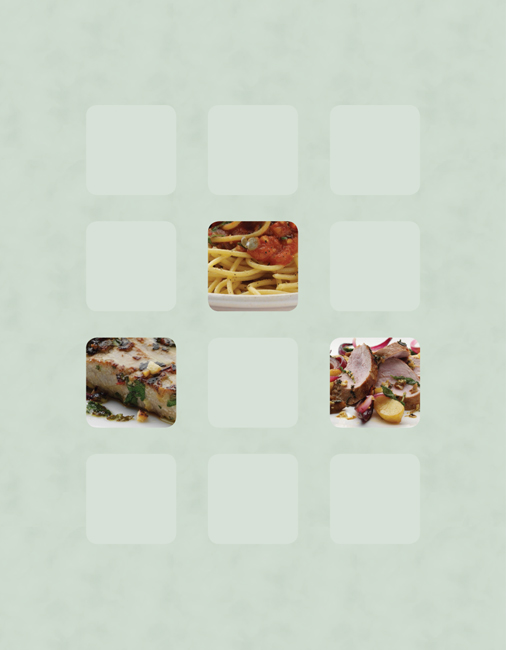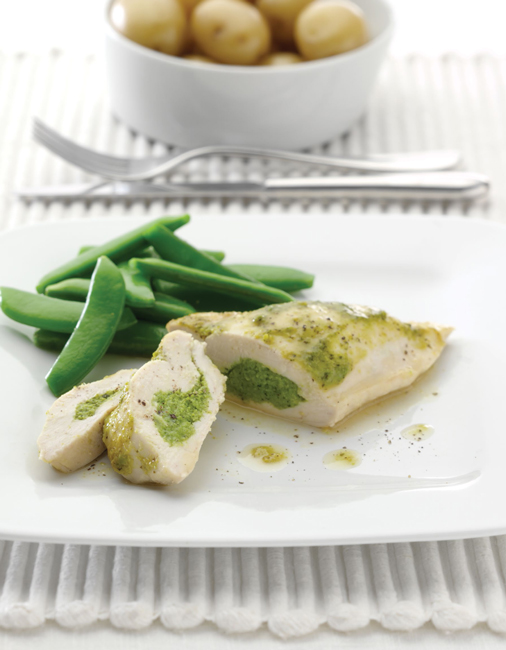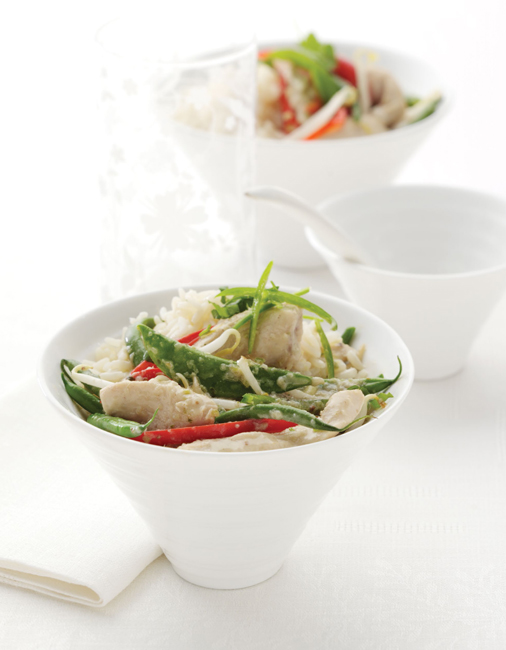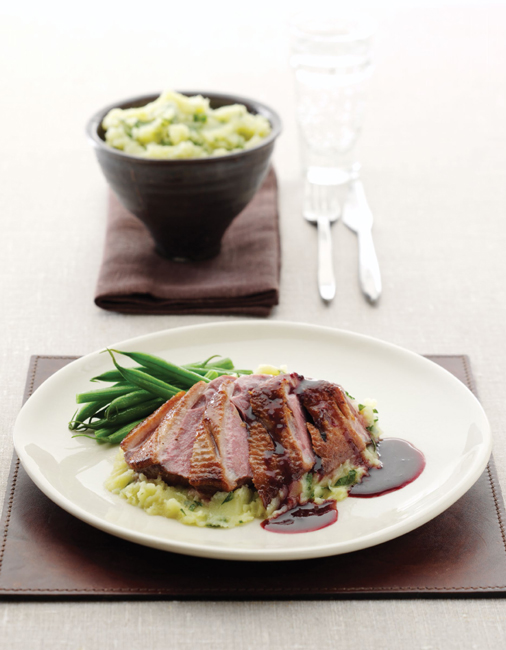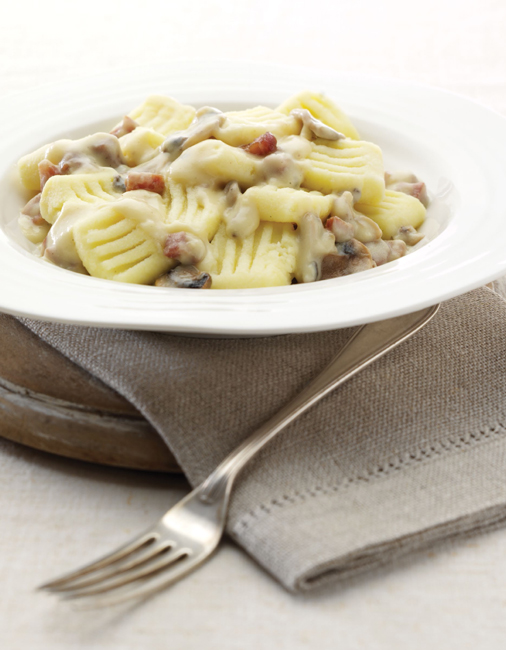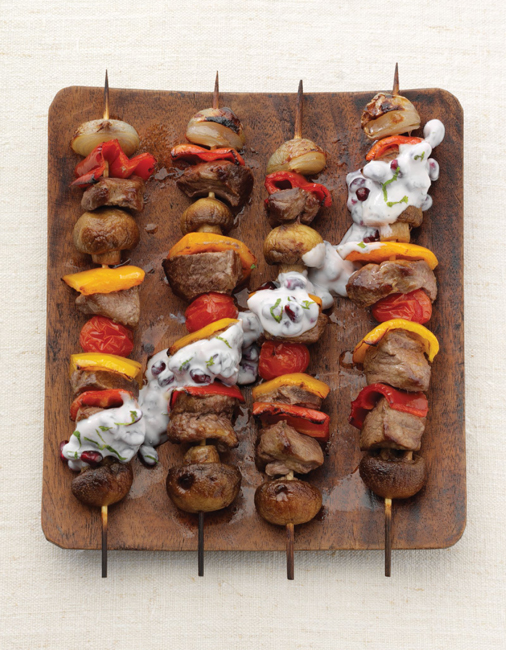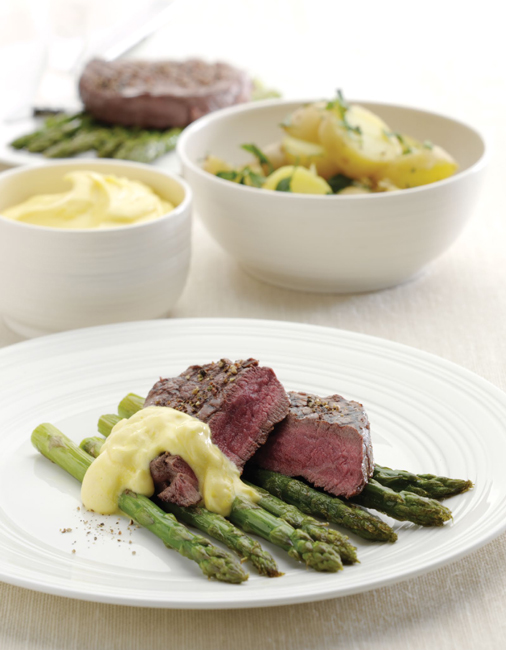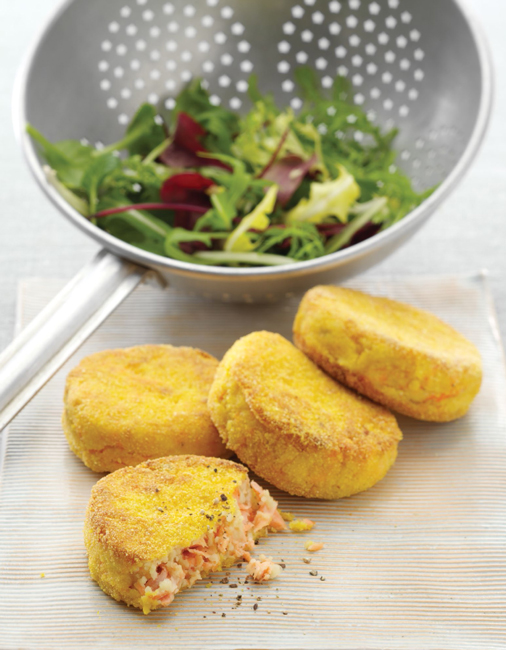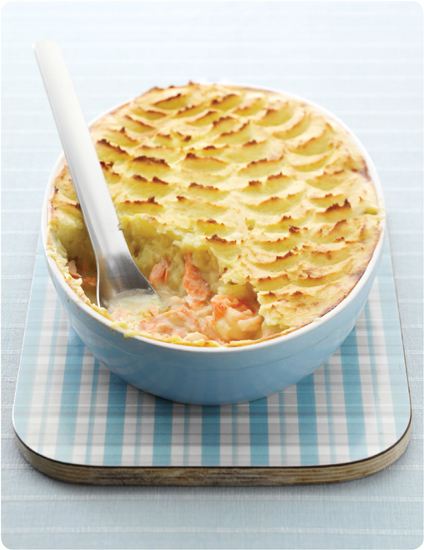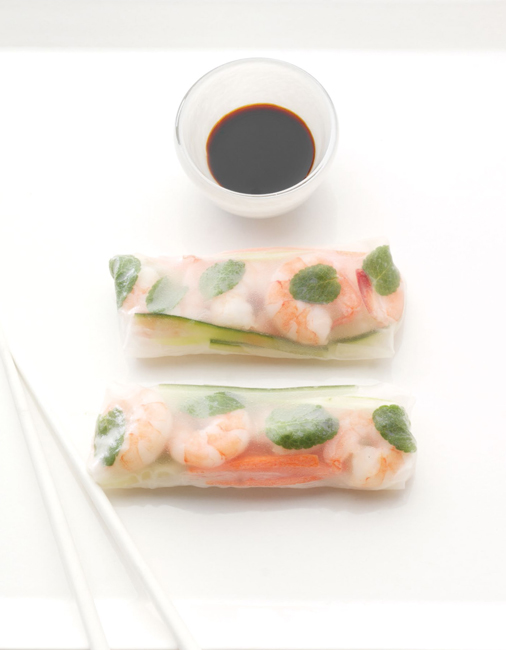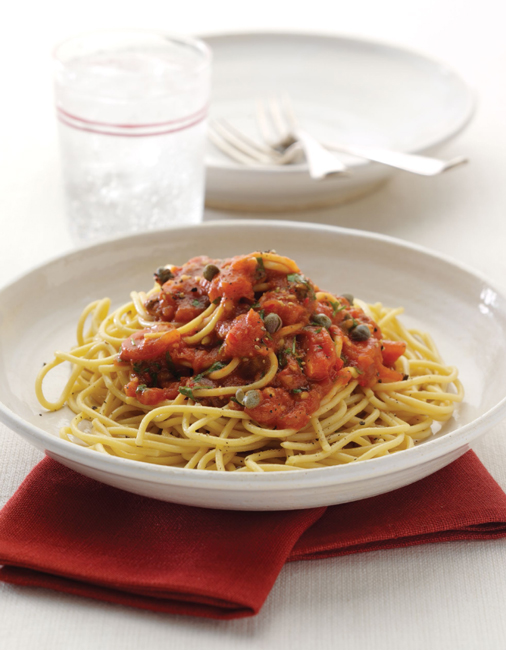If you thought you couldn’t have risotto any longer, or pasta or curry, think again. This chapter is packed with mouth-watering main courses, many of which you’ll be amazed to find you can eat. Delicious Gnocchi with Mushroom and Pancetta Sauce will provide a substantial, warming meal, and Salmon Fishcakes, with their crunchy coating, will be a hit with your kids. Choose from a range of quick suppers that can be whipped up in less than 30 minutes, such as Pork with Chestnuts, Apple and Sage, much-loved family favourites, such as Spaghetti with Meatballs, or indulgent meals for a special occasion, such as Duck with Cherry and Juniper Sauce or Herbed Monkfish Wrapped in Parma Ham. This is food for everyone – for sharing good times together.

chicken farci with pea and mint purée
PREPARATION TIME 10 MINUTES, PLUS 2 HOURS MARINATING TIMECOOKING TIME 35 MINUTESADDITIONAL TIME MAKING THE STOCKSERVES 4
4 skinless, boneless chicken breasts
8 tbsp olive oil
juice of 1 lime
2 shallots, finely chopped
500g/1lb 2oz peas in their pods, shelled (200g/7oz/1¼ heaped cups shelled)
200ml/ 7fl oz/generous ¾ cup Vegetable Stock (see page 25), or stock made from gluten-, yeast- and dairy-free stock powder
2 heaped tbsp chopped mint leaves
25g/1oz silken tofu, chopped
sea salt and freshly ground black pepper
- Arrange the chicken breasts in a large dish. Mix 6 tbsp of the oil with the lime juice in a small jug, then pour over the chicken. Cover and leave in the fridge to marinate for 2 hours.
- Preheat the oven to 180°C/350°F/Gas 4. Heat the remaining oil in a heavy-based saucepan, add the shallots and fry over a low heat for 1–2 minutes. Add the peas and stock and cook for 5 minutes. Stir in the mint, then season lightly with salt and pepper.
- Add the tofu to the saucepan, then blend with a hand-held electric blender. Alternatively, blend the mixture in a liquidizer or food processor. Pour the mixture into a sieve set over a bowl and work it through with a wooden spoon to form a smooth purée, reserving the liquid.
- Remove the chicken from the dish, discarding the marinade. Make a long horizontal slit through the thickest part of each breast without cutting right through, to create a pocket. Stuff as much purée as you can into each pocket, then close up the opening with wooden cocktail sticks.
- Place the stuffed chicken breasts in an ovenproof dish and spread the remaining purée over the top of each breast. Pour the reserved liquid onto the base of the dish, taking care not to pour it onto the chicken. Bake in the hot oven for 25 minutes until the chicken is cooked through. Remove the cocktail sticks and serve with boiled new potatoes and vegetables.


PREPARATION TIME 5 MINUTESCOOKING TIME 25–30 MINUTESADDITIONAL TIME MAKING THE STOCKSERVES 4
800ml/1½ pints/scant 3½ cups Chicken or Vegetable Stock (see pages 24–5), or vegetable stock made from gluten-, yeast- and dairy-free stock powder
6 tbsp olive oil
4 skinless, boneless chicken breasts, cut into bite-sized pieces
1 small onion, finely chopped
2 tbsp chopped flat-leaf parsley
2 tbsp chopped mint leaves
2 tbsp chopped basil leaves
250g/9oz/heaped 1 cup arborio or other risotto rice
300ml/10fl oz/scant 1¼ cups organic dry white wine
sea salt and freshly ground black pepper
- Heat the stock in a saucepan until almost boiling, then turn the heat down, cover with a lid and leave to simmer while you prepare the rice mixture.
- Heat 2 tbsp of the oil in a large, heavy-based saucepan. Add the chicken and cook over a medium heat for 5–6 minutes until lightly browned. Remove from the pan with a slotted spoon and leave to one side.
- Put the remaining oil in the pan and heat until hot. Add the onion and cook on a medium heat for 2–3 minutes until starting to turn golden, then stir in half of the chopped herbs. Add the rice and stir thoroughly so that each grain is coated with oil.
- Pour a little of the wine into the mixture and stir. Continue cooking over a low heat, gradually adding and stirring in the wine, until it has all been absorbed. Add the chicken and a ladle of the simmering stock and stir until all the liquid has been absorbed. Continue adding stock and stirring for about 18–20 minutes until the rice is just tender but still has a little bite and all the liquid has been absorbed.
- Stir in the remaining herbs and season lightly with salt and pepper. Serve with mixed salad leaves.

PREPARATION TIME 10 MINUTESCOOKING TIME 10–12 MINUTESSERVES 4
1 tbsp olive oil
4 skinless, boneless chicken breasts
350g/12oz green beans, trimmed
500g/1lb 2oz baby leaf spinach
Salsa verde:
2 heaped tbsp chopped basil leaves
2 heaped tbsp chopped mint leaves
2 heaped tbsp chopped flat-leaf parsley
1 garlic clove, chopped
6 anchovies in oil, drained and chopped
2 tbsp capers in brine, rinsed
juice of ½ lemon
2 tbsp olive oil
- Make the salsa verde by putting the herbs, garlic, anchovies and capers into a food processor and blending to form a paste. With the motor running, gradually pour in the lemon juice and oil until well combined. Transfer to a bowl and cover.
- Heat the oil in a large, heavy-based saucepan, add the chicken, cover with a lid and cook over a medium heat, turning occasionally, for 10–12 minutes until cooked through.
- About halfway through the cooking time, place the beans in a steamer and steam for 2 minutes. Add the spinach and continue cooking for another minute until the beans are just tender and the spinach is beginning to wilt.
- Spread the salsa verde over the chicken pieces and serve with the beans and spinach and with fried or grilled slices of Quick Polenta (see page 143) and mixed salad leaves.



thai-style green chicken curry
PREPARATION TIME 10 MINUTESCOOKING TIME 20–25 MINUTESADDITIONAL TIME MAKING THE CURRY PASTESERVES 4
2 tbsp olive oil
4 skinless, boneless chicken breasts, cut into thin strips
400ml/14fl oz/1⅔ cup tinned coconut milk
2 tbsp Thai Green Curry Paste (see page 20)
3 tbsp Thai fish sauce
4 kaffir lime leaves, or a strip of lime peel
100g/3½oz green beans, trimmed
1 red or yellow pepper, deseeded and cut into thin strips
100g/3½oz sugar snap peas
100g/3½oz beansprouts
1 small handful sweet basil leaves, cut in half
½ large green chilli, deseeded and cut into fine strips
1 large handful coriander leaves
- Heat a wok until hot, pour in the oil and swirl it around. Add the chicken and cook over a medium heat, stirring continuously, for 2–3 minutes until lightly browned, then remove and put on a plate. Pour the coconut milk into the wok and cook gently for 4–5 minutes. Add the curry paste and cook for 2–3 minutes, stirring well.
- Add the fish sauce, lime leaves or strip of lime peel, green beans and pepper and cook gently for 3–4 minutes. Take care not to let it boil or the coconut milk will curdle. Add the sugar snap peas and beansprouts and cook for 10 minutes until the chicken is cooked.
- Check the seasoning and add a little more fish sauce if desired. Sprinkle with the basil, chilli and coriander and serve with steamed basmati rice.


PREPARATION TIME 10 MINUTESCOOKING TIME 1% HOURSADDITIONAL TIME MAKING THE STOCKSERVES 4
1.8kg/4lb chicken
1 tbsp olive oil
1 large garlic clove, sliced
4 rosemary sprigs
800g/1lb 12oz potatoes, peeled and cut into quarters
250ml/9fl oz/1 cup Chicken or Vegetable Stock (see pages 24–5), or vegetable stock made from gluten-, yeast- and dairy-free stock powder
250ml/9fl oz/1 cup organic dry white wine
sea salt and freshly ground black pepper
- Preheat the oven to 180°C/350°F/Gas 4. Place the chicken in a large ovenproof dish and rub the oil over it. With a sharp knife, make incisions in the flesh along the breast and top of the thighs. Insert a slice of garlic into each incision, pushing it down into the flesh. Lay the rosemary sprigs over the top of the chicken.
- Arrange the potatoes around the sides of the chicken and season both the chicken and potatoes lightly with salt and pepper. Pour the stock and wine into the base of the dish and cover the dish with greaseproof paper, ensuring the ends of the paper are tucked under the dish.
- Roast in the hot oven for 1 hour. Remove the greaseproof paper and leave to one side. Cook for a further 40 minutes until the juices from the chicken run clear when the thickest part of the thigh is pierced with a skewer. If the juices look at all pink, cook for a little longer. Take the chicken and potatoes out of the oven and replace the greaseproof paper, ensuring the ends of the paper are tucked under the dish, and leave to stand in a warm place for 10–15 minutes.
- Meanwhile, tip the cooking juices into a jug and, using a spoon, remove and discard the layer of fat that will rise to the surface. Pour the juices into a saucepan and cook over a high heat for 2–3 minutes to reduce. Serve with the chicken and potatoes along with Roasted Vegetables (see page 145), Italian-Style Vegetables (see page 148) or Red Cabbage and Apple (see page 147).

PREPARATION TIME 15 MINUTES, PLUS 2 DAYS CHILLING TIMECOOKING TIME 2 HOURSSERVES 4
4 large duck legs
25g/1oz sea salt
2 garlic cloves, crushed
6 thyme sprigs
1kg/2lb 4oz goose or duck fat
- Arrange the duck legs, skin-side up, in an ovenproof dish just large enough to hold them. Sprinkle over the salt and garlic and place the sprigs of thyme on top. Cover with a lid and leave in the fridge for 24 hours. Do not leave any longer, as the duck will become too salty.
- Take the duck out of the dish and wipe thoroughly with kitchen paper to remove all the salt. Clean the dish and arrange the duck legs in it as before. Preheat the oven to 140°C/275°F/ Gas 1.
- Heat the goose or duck fat in a saucepan over a low heat until starting to bubble, then pour it into the dish, covering all the duck pieces. Cover and cook in the warm oven for 1½ hours. Take the duck out of the oven and leave to cool.
- Take the cooled duck legs out of the dish and put on a plate. Pour the remaining fat through a sieve into a bowl and discard any meat juices that are left on the bottom of the dish. Clean the dish and return the duck legs to it. Pour over the strained fat, cover the dish and leave to chill in the fridge for 24 hours.
- Preheat the oven to 180°C/350°F/Gas 4. Remove the duck from the dish and wipe off most of the fat. Place the duck on a rack above a roasting tin and cook in the hot oven for 20 minutes until the skin is crisp and golden and the meat is cooked through. Take the duck out of the oven and serve with Red Cabbage and Apple (see page 147) and Potatoes with Porcini Mushrooms (see page 142).


duck with cherry and juniper sauce
PREPARATION TIME 10 MINUTESCOOKING TIME 25–35 MINUTESSERVES 4
450g/1lb cherries, cut in half and pitted
5 juniper berries, crushed
175ml/6fl oz/ % cup organic red wine
4 duck breasts
½ tsp sea salt
1 tbsp olive oil
1 tsp cornflour
2–3 tsp sugar-free cherry jam
- Preheat the oven to 180°C/350°F/Gas 4. Place the cherries and juniper berries in a saucepan with the red wine. Bring to the boil over a medium heat, then turn the heat down, cover with a lid and leave to simmer for 10–15 minutes until the cherries have softened, crushing them from time to time with the back of a wooden spoon.
- Meanwhile, slash the skin of each duck breast and sprinkle the salt over them. Heat the oil in a heavy-based frying pan. Add the duck, skin-side down, and cook over a medium-high heat for 4–5 minutes until the skin is browned. Using a slotted spoon, lift the duck breasts from the pan and arrange in a roasting tin, skin-side up. Pour the juices from the pan over the top. Cook the duck in the hot oven for 20–25 minutes until the skin is crisp but the meat is still slightly pink in the middle.
- When the cherries have softened, remove from the heat and pour the mixture through a non-metallic sieve set over a bowl, using the back of a metal spoon to push as much of the liquid through as possible. Discard the contents of the sieve. Rinse the saucepan, pour the liquid back into it and return to the heat. Bring to the boil, then turn the heat down and leave to simmer for 15–20 minutes, stirring occasionally, until reduced by half.
- Mix 1 tsp water with the cornflour in a small bowl to make a smooth paste. Stir into the simmering cherry and juniper liquid and continue to simmer for a further 4–5 minutes, stirring occasionally, until the sauce has thickened. Stir in the jam to taste.
- When the duck has cooked, take it out of the oven and serve with the sauce, Olive Oil Herb Mash (see page 141) and vegetables.


pork with chestnuts, apple and sage
PREPARATION TIME 10 MINUTESCOOKING TIME 12–15 MINUTESSERVES 4
2 tbsp olive oil
1 red onion, sliced lengthways into 16 pieces
1 garlic clove, crushed
650g/1lb 7oz pork tenderloin, trimmed of fat and cut into bite-sized chunks
100g/3½oz cooked, peeled chestnuts (fresh or vacuum-packed), cut into thirds
2 eating apples, peeled, quartered and cored, and sliced lengthways into 16 pieces
1 heaped tbsp chopped sage leaves
sea salt and freshly ground black pepper
- Heat the oil in a large, heavy-based saucepan. Add the onion and fry over a gentle heat for 2 minutes until just starting to turn golden. Stir in the garlic and then the pork, cover with a lid and cook for 5 minutes, shaking the pan occasionally to turn the pork.
- Remove the lid, add the chestnuts, apples and sage and cook for 5–8 minutes until the apple is soft and the liquid has evaporated. Season lightly with salt and pepper and serve the pork with Herb Mash (see page 141) made with a small handful sage instead of the parsley or coriander and vegetables.


PREPARATION TIME 5 MINUTESCOOKING TIME 11–13 MINUTESSERVES 4
4 tbsp olive oil
650g/1lb 7oz pork tenderloin, trimmed of fat and sliced into 2cm/ ¾in rounds
2 bunches spring onions, finely sliced
Umeboshi sauce:
150ml/5fl oz/scant ⅔ cup clear honey
2 tbsp umeboshi paste
2 tbsp tamari soy sauce
1 tsp Chinese five-spice powder
- Mix together the sauce ingredients in a jug or bowl until well blended.
- Heat the oil in a large wok, add the pork and stir-fry over a high heat for 5–6 minutes, stirring continuously. Add the spring onions and stir-fry for 1 minute.
- Pour the umeboshi sauce over and cook for 5–6 minutes, stirring occasionally, until the pork is cooked through and the sauce has reduced a little. Serve with steamed rice.



gnocchi with mushroom and pancetta sauce
PREPARATION TIME 20 MINUTESCOOKING TIME 25–30 MINUTESADDITIONAL TIME MAKING THE SAUCESERVES 4
2 tbsp olive oil
1 onion, finely chopped
2 garlic cloves, crushed
350g/12oz nitrate-free pancetta, chopped
300g/10oz mushrooms, sliced
1 recipe quantity White Wine Sauce (see page 19)
sea salt and freshly ground black pepper
Gnocchi:
750g/1lb 9oz potatoes, peeled and cut into large chunks
3 egg yolks, beaten
125g/4oz/scant ¾ cup rice flour, plus extra for dusting
sea salt and freshly ground black pepper
- To make the gnocchi, put the potatoes in a saucepan and cover with cold water. Place over a high heat, bring to the boil, then turn the heat down, cover with a lid and leave to simmer for 15–20 minutes until tender. Meanwhile, heat the oil for the sauce in a heavy-based frying pan. Add the onion and cook over a medium heat for 2–3 minutes until starting to turn golden. Stir in the garlic, then add the pancetta and fry for 3–4 minutes. Add the mushrooms and cook for 10 minutes, stirring occasionally.
- When the potatoes are cooked, drain and mash well, then warm over a low heat for a few minutes. Tip into a large bowl, season lightly with salt and pepper, then beat in the egg yolks and flour, a little at a time, with a wooden spoon to form a smooth, slightly sticky dough.
- Turn the dough out onto a surface dusted with rice flour and, with floured hands, knead and work it into a ball. Roll out to form into a long sausage about 2cm/ ¾in in diameter. Cut into 2cm/ ¾in lengths, then use the back of a fork to make grooves across the top of each piece. Leave on the floured surface, making sure they do not overlap.
- Fill a large saucepan with boiling water and set over a medium heat so that the water simmers gently. Add a third of the prepared gnocchi and cook until they rise to the surface. Continue cooking for another 1–2 minutes, then remove with a slotted spoon and keep warm. Repeat with the remaining gnocchi.
- Meanwhile, heat the white wine sauce over a gentle heat until almost boiling. Stir in the pancetta mixture and season lightly with salt and pepper. Pour the sauce over the gnocchi and serve.

roasted squash, leek and bacon risotto
PREPARATION TIME 5 MINUTESCOOKING TIME 45 MINUTESADDITIONAL TIME MAKING THE STOCKSERVES 4
1kg/2lb 4oz butternut or other squash, peeled, deseeded and cut into bite-sized pieces
3 tbsp olive oil
1 litre/1¾ pints/4 cups Chicken or Vegetable Stock (see pages 24–5), or vegetable stock made from gluten-, yeast- and dairy-free stock powder
1 small onion, finely chopped
2 garlic cloves, crushed
3 leeks, about 400g/14oz total weight, trimmed and sliced
6 rashers rindless nitrate-free back bacon, about 200g/ 7oz total weight, diced
250g/9oz/heaped 1 cup arborio or other risotto rice
sea salt and freshly ground black pepper
- Preheat the oven to 180°C/350°F/Gas 4. Place the squash in a roasting tin, drizzle over 2 tbsp of the oil and roast in the hot oven for 45 minutes, until tender.
- When the squash has been roasting for about 15 minutes, heat the stock in a saucepan until almost boiling, then turn the heat down, cover with a lid and leave to simmer.
- Heat the remaining oil in a large, heavy-based saucepan over a medium heat. Add the onion and cook for 2–3 minutes until just starting to turn golden. Stir in the garlic and cook for about 30 seconds, then add the leeks and bacon. Lower the heat and continue cooking for a further 3–4 minutes until the bacon has cooked through and the leeks have softened.
- Stir in the rice until it is well coated in oil, then add a ladle of the hot stock and stir until all the liquid has been absorbed. Continue adding and stirring in the hot stock for 18–20 minutes until the rice is soft but still has a slight bite and all the liquid has been absorbed.
- Take the squash out of the oven and stir it carefully into the risotto. Season lightly with salt and pepper and serve with mixed salad leaves.



PREPARATION TIME 10 MINUTESCOOKING TIME 1% HOURSADDITIONAL TIME MAKING THE STOCK AND THE RAS EL HANOUTSERVES 4
125ml/4fl oz/ ½ cup Vegetable Stock (see page 25), or stock made from gluten-, yeast- and dairy-free stock powder
¼ tsp saffron strands
3 tbsp olive oil
650g/1lb 7oz boneless shoulder of lamb, trimmed of fat and cut into bite-sized pieces
2 onions, finely chopped
2 garlic cloves, crushed
2 tbsp Ras el Hanout (see page 20)
200g/ 7oz sugar-free dried unsulphured apricots, cut in half
100g/3½oz/⅔ cups whole blanched almonds
3 tbsp clear honey
- Heat the stock in a saucepan until almost boiling. Remove from the heat and stir in the saffron.
- Heat 2 tbsp of the oil in a large, heavy-based saucepan over a medium heat. Add the lamb and cook for 3–4 minutes, stirring occasionally, until lightly browned. Remove the lamb from the pan using a slotted spoon and put in a bowl and drain off any juices into the bowl.
- Heat the remaining oil in the pan over a medium heat. Add the onions and cook for 1–2 minutes until slightly softened. Stir in the garlic, then the Ras el Hanout and cook for about 30 seconds. Return the lamb and juices to the pan and add the apricots, almonds, honey and stock.
- Bring to the boil, then turn the heat down, cover with a lid and leave to simmer for 1½ hours, stirring occasionally. Skim off any fat from the surface and serve with steamed rice and vegetables.

lamb skewers with pomegranate and yogurt sauce
PREPARATION TIME 10 MINUTES, PLUS 30 MINUTES MARINATING TIMECOOKING TIME 8–12 MINUTESSERVES 4
500g/1lb 2oz lamb fillet, trimmed of fat and cut into bite-sized pieces
3 peppers (a mixture of red, orange and yellow, or all one colour), deseeded and cut into large chunks
8 shallots, peeled and cut in half lengthways
200g/ 7oz closed-cup mushrooms
200g/ 7oz cherry tomatoes
150ml/5fl oz/scant ⅔ cup olive oil
Sauce:
1 pomegranate
300g/10oz soya yogurt
1½ tbsp finely chopped mint leaves
sea salt
- Put the lamb in a large, flat, non-metallic dish and season lightly with salt. Add the peppers, shallots, mushrooms and tomatoes and pour the oil over them. Cover and leave to marinate for at least 30 minutes while soaking eight wooden skewers in water.
- Preheat the grill to high. Thread the lamb and vegetables onto the skewers, alternating each ingredient. Place on the grill rack and cook under the hot grill for 4–6 minutes on each side until the lamb is crisp and brown on the outside but still pink in the middle.
- Meanwhile, halve the pomegranate and, holding each half over a large bowl, bash the outer skin with a wooden spoon until all the seeds fall out into the bowl. You’ll need to bash the skin a few times before the pips begin to fall out, but they will. Mix in the yogurt and mint and season lightly with salt. Serve the skewers with the sauce and steamed rice.

PREPARATION TIME 5 MINUTESCOOKING TIME 12–20 MINUTESSERVES 4
25g/1oz dairy-free margarine
2 small red onions, finely chopped
1–1½ tsp paprika
350g/12oz closed-cup mushrooms, sliced
600g/1lb 5oz fillet steak, cut into strips
3 tbsp olive oil
400g/14oz soya yogurt
1 large handful flat-leaf parsley, finely chopped
sea salt and freshly ground black pepper
- Melt the margarine in a large, heavy-based saucepan. Add the onions and 1 tsp paprika and cook over a medium heat for 2–3 minutes until starting to turn golden. Stir in the mushrooms and cook for 5–7 minutes. Tip the onions and mushrooms onto a plate.
- Season the steak lightly with salt and pepper. Heat 2 tbsp of the oil in the saucepan over a high heat. Add half the seasoned steak and cook for 2–4 minutes, turning, until browned. Remove from the pan using a slotted spoon and leave to one side. Repeat with the remaining oil and steak.
- Return the onions and mushrooms to the pan. Using a whisk or a hand-held electric blender, blend the yogurt until smooth. Stir the yogurt into the mixture and heat through gently for 1–2 minutes, taking care not to overcook, as the yogurt will curdle. Stir in the steak and parsley, then check the seasoning and add more paprika if required. Serve with steamed rice and vegetables.


PREPARATION TIME 10 MINUTESCOOKING TIME 20–25 MINUTESADDITIONAL TIME MAKING THE SAUCESERVES 4
3 tbsp olive oil
1 onion, finely chopped
1 garlic clove, crushed
600g/1lb 6oz minced steak
1 egg, beaten
1 large handful flat-leaf parsley, finely chopped
400g/14oz gluten-free spaghetti, or other gluten-free pasta shape
1 recipe quantity Tomato and Pepper Sauce (see page 18)
sea salt and freshly ground black pepper
- Heat 1 tbsp of the oil in a large, heavy-based frying pan. Add the onion and cook over a medium heat for 2–3 minutes until turning golden. Add the garlic and cook for 30 seconds.
- Tip the onion and garlic into a large mixing bowl. Add the minced steak, egg and parsley and season lightly with salt and pepper. Mix well to combine the ingredients, then divide the mixture into 16 pieces and shape each into a ball with your hands.
- Heat the Tomato and Pepper Sauce in a large, heavy-based saucepan over a gentle heat until almost boiling and leave to simmer.
- Heat another 1 tbsp of the oil in the frying pan. Add half the meatballs and cook over a medium heat for 8–10 minutes, moving them around the pan so that they brown evenly and are cooked through. Remove from the frying pan with a slotted spoon and add to the saucepan with the Tomato and Pepper Sauce. Repeat with the remaining meatballs.
- Meanwhile, bring a large saucepan of water to the boil. Add the remaining oil, then the spaghetti, pushing it down into the water as it softens. Cook over a medium heat for 8–10 minutes, or according to the packet instructions, stirring frequently to make sure the spaghetti does not stick together. Drain, then rinse well with boiling water and drain again. Serve with the meatballs in the Tomato and Pepper Sauce and with mixed salad leaves.



steak with baked asparagus and hollandaise sauce
PREPARATION TIME 5 MINUTESCOOKING TIME 10–12 MINUTESADDITIONAL TIME MAKING THE SAUCESERVES 4
500g/1lb 2oz asparagus, woody ends removed
2½ tbsp olive oil
4 fillet steaks
1 recipe quantity Hollandaise Sauce (see page 19)
sea salt and freshly ground black pepper
- Preheat the oven to 180°C/350°F/Gas 4. Place the asparagus on a baking tray. Drizzle with 1½ tbsp of the oil and bake in the hot oven for 10–12 minutes until cooked through.
- Meanwhile, heat the remaining oil in a large, heavy-based frying pan. Season the steaks lightly with salt and pepper, add to the pan and cook over a medium heat for 3–5 minutes on each side for medium-rare or another 1–2 minutes for well done. Alternatively, brush the steaks with the remaining oil and cook under a hot grill.
- Take the asparagus out of the oven and serve with the steak and the hot Hollandaise Sauce, and with boiled new potatoes or jacket potatoes.


PREPARATION TIME 10 MINUTES, PLUS 1 HOUR MARINATING TIMECOOKING TIME 6–8 MINUTESSERVES 4
4 tuna steaks
1 tbsp olive oil
Marinade:
2cm/ ¾in piece fresh ginger, peeled and finely chopped
2 large garlic cloves, finely chopped
1 small or ½ large red chilli, deseeded and finely chopped
2 heaped tbsp chopped mint leaves
2 heaped tbsp chopped basil leaves
1 handful coriander leaves, finely chopped
3 tbsp olive oil
1 tbsp Thai fish sauce
juice of 2 limes
- Place the tuna in a shallow, non-metallic dish. Mix together all the marinade ingredients in a bowl or jug and pour over the tuna. Cover with a lid or cling film and leave to marinate in the fridge for at least 1 hour, preferably longer.
- Heat the oil in a heavy-based frying pan over a medium heat. Place the tuna in the hot pan, spoon the marinade on top of each steak and pour the remaining liquid into the base of the pan. Cook for 3–4 minutes on each side until the tuna is lightly browned on the outside but remains slightly pink in the centre. Serve with Vegetable Stir-Fry (see page 146).


PREPARATION TIME 5 MINUTES, PLUS 1 HOUR MARINATING TIMECOOKING TIME 30–35 MINUTESSERVES 4
4 salmon fillets
2.5cm/1in piece fresh ginger, peeled and finely chopped
1 bunch spring onions, finely chopped
2 tbsp tamari soy sauce
2 tbsp clear honey
- Place the salmon fillets in a large ovenproof dish, skin-side down. Sprinkle the ginger and spring onions over the top, then pour the tamari soy sauce and honey over. Cover with a lid and leave to marinate in the fridge for at least 1 hour, preferably longer.
- Preheat the oven to 180°C/350°F/Gas 4. Place the dish in the hot oven and cook for 30–35 minutes until the salmon is cooked through.
- Take the salmon fillets out of the oven and serve with the sauce from the dish and steamed rice or Herb Mash (see page 141) and vegetables.


PREPARATION TIME 15 MINUTES, PLUS 30 MINUTES CHILLING TIMECOOKING TIME 35–45 MINUTESSERVES 4
500g/1lb 2oz salmon fillets
2 tbsp olive oil
500g/1lb 2oz potatoes, peeled and cut into large chunks
2 large eggs, beaten
gram flour, for dusting
polenta or maize flour, for dusting
sea salt and freshly ground black pepper
- Preheat the oven to 180°C/350°F/Gas 4. Place the salmon in an ovenproof dish and drizzle over half of the oil. Cover and bake in the hot oven for 20–25 minutes until cooked through.
- Meanwhile, put the potatoes in a saucepan and cover with cold water. Place over a high heat, bring to the boil, then turn the heat down, cover with a lid and leave to simmer for 15–20 minutes until tender. Drain, return to the saucepan and heat gently for 1–2 minutes to dry out. Mash coarsely.
- Take the salmon out of the oven, remove and discard the skin and any brown meat, and flake with a fork, reserving any juices. Mix together the flaked salmon, mashed potatoes, half the beaten eggs, the reserved cooking juices and some salt and pepper, taking care not to break up the fish too much. With wet hands, shape the salmon mixture into eight balls, then flatten them slightly to form fishcakes.
- Spread the gram flour out on a plate and the polenta or maize flour out on a second plate. Dip each fishcake into the gram flour to coat it, then into the remaining beaten egg, then finally into the polenta or maize flour until well coated. Place on a clean plate, cover with cling film and leave to chill in the fridge for at least 30 minutes.
- Heat the remaining oil in a large, heavy-based frying pan over a medium heat. Add half the fishcakes and cook for 4–5 minutes on each side until golden brown. Keep warm while you cook the remaining fishcakes. Serve with vegetables or mixed salad leaves.

herbed monkfish wrapped in parma ham
PREPARATION TIME 10 MINUTES, PLUS 2 HOURS CHILLING TIMECOOKING TIME 12–16 MINUTESSERVES 4
600g/1lb 5oz monkfish fillet, cut lengthways into four long pieces
1 large handful chopped coriander leaves
1 large handful chopped flat-leaf parsley
juice of 1 lemon
6 tbsp olive oil
8 slices nitrate-free Parma ham
sea salt and freshly ground black pepper
- Place the monkfish pieces in a shallow, non-metallic dish. Mix together the coriander, parsley, lemon juice and oil in a jug and season lightly with salt and pepper. Pour over the fish, cover the dish and leave to marinate in the fridge for at least 2 hours.
- Preheat the grill to high. Place two slices of Parma ham, side by side, on a clean surface. Remove one piece of monkfish from the dish, making sure that it is well coated in chopped herbs from the marinade, and lay it across the slices of ham. Carefully roll the ham around the herbed fish. Repeat with the remaining pieces of fish and ham.
- Arrange the ham-wrapped pieces of fish on the grill rack and cook under the hot grill for 6–8 minutes on each side until the fish is cooked. Serve with boiled new potatoes and Italian-Style Vegetables (see page 148).


baked sea bass with tarragon sauce and fennel purée
PREPARATION TIME 15 MINUTESCOOKING TIME 1 HOURADDITIONAL TIME MAKING THE STOCKSSERVES 4
3 tbsp olive oil
3 shallots, finely chopped
375ml/13fl oz/1½ cups organic dry white wine
500ml/17fl oz/2 cups Fish Stock (see page 24), or vegetable stock made from gluten-, yeast- and dairy-free stock powder
12 tarragon sprigs
2 large or 4 medium sea bass, gutted and cleaned
1 tbsp cornflour
150ml/5fl oz/scant ⅔ cup sugar-free soya milk
30g/1¼oz silken tofu
Fennel purée:
2 fennel bulbs, trimmed and sliced lengthways
175ml/6fl oz/ ¾ cup Vegetable Stock (see page 25), or stock made as before
sea salt and freshly ground black pepper
- Preheat the oven to 180°C/350°F/Gas 4. Heat 2 tbsp of the oil in a large, heavy-based saucepan over a medium heat. Add the shallots and cook for 1–2 minutes until starting to turn golden. Add the wine, bring to the boil, then turn the heat down and leave to simmer for 15–20 minutes until the liquid has reduced. Add the fish stock, return to the boil, then turn the heat down and leave to simmer for a further 20 minutes.
- Meanwhile, place the fennel and vegetable stock in a saucepan and bring to the boil. Lower the heat, cover with a lid and simmer for 10 minutes until the fennel is soft. Using a hand-held electric blender, blend to form a smooth purée. Alternatively, blend in a liquidizer or food processor. Season lightly with salt and pepper and keep warm.
- Divide eight of the tarragon sprigs between the cavities in the fish. Place the fish in an ovenproof dish, drizzle over the remaining oil and bake in the hot oven for 20–30 minutes until cooked through.
- Mix 1 tbsp water and the cornflour in a bowl to form a smooth paste. Add the soya milk and tofu and, using a hand-held blender, blend the mixture until smooth. Pour into the stock mixture, turn the heat up and bring the sauce to the boil, stirring constantly. Turn the heat down and leave to simmer for 8–10 minutes until the sauce is thick enough to coat the back of a spoon. Chop the remaining tarragon finely and stir into the sauce.
- Take the fish out of the oven and serve with the fennel purée, the tarragon sauce and boiled new potatoes.


PREPARATION TIME 10 MINUTESCOOKING TIME 50–60 MINUTESADDITIONAL TIME MAKING THE STOCK AND THE SAUCESERVES 4
500g/1lb 2oz salmon fillets
1 bay leaf
700ml/1¼ pints/scant 3 cups Fish Stock (see page 24), or vegetable stock made from gluten-, yeast- and dairy-free stock powder
1kg/2lb 4oz potatoes, peeled and cut into large chunks
4 tbsp sugar-free soya milk
1 egg, beaten
50g/2oz dairy-free margarine
250g/9oz cooked, peeled king prawns, deveined
1 recipe quantity Béchamel Sauce (see page 18)
sea salt and freshly ground black pepper
- Place the salmon in a large, heavy-based saucepan, add the bay leaf and fish stock and bring to the boil over a medium heat. Turn the heat down, cover with a lid and leave to simmer for 8 minutes until the fish is cooked through. Remove from the pan using a slotted spoon and leave to cool. Reserve the cooking liquid.
- Meanwhile, preheat the oven to 200°C/400°F/Gas 6. Put the potatoes in a large saucepan and cover with cold water. Place over a high heat, bring to the boil, then turn the heat down, cover with a lid and leave to simmer for 15–20 minutes until tender. Drain, stir in 4 tbsp of the reserved fish cooking liquid, the soya milk, egg and margarine and season lightly with salt and pepper. Mash until well blended and smooth, using a hand-held electric blender if you want a very smooth result.
- When the salmon has cooled enough to handle, remove and discard the skin and any brown meat. Break into large, bite-sized chunks and arrange in the bottom of a 2.5-litre/ 4-pint/10-cup ovenproof dish. Place the prawns on top and pour the Béchamel Sauce over to cover the fish.
- Spoon the mashed potato over, spreading it evenly. Bake in the hot oven for 35–40 minutes until the top is golden, then take it out of the oven and serve with vegetables.


PREPARATION TIME 15 MINUTESCOOKING TIME 5–7 MINUTESSERVES 4
2kg/4lb 8oz fresh mussels in their shells
50g/2oz dairy-free margarine
2 small onions, finely chopped
1 garlic clove, finely chopped
250ml/9fl oz/1 cup organic dry white wine
60g/2¼oz soya yogurt
1 large handful chopped flat-leaf parsley
sea salt and freshly ground black pepper
- Scrub the mussels thoroughly with a stiff brush under cold running water to remove all traces of grit, then remove any barnacles or other debris attached to the shells and pull off and discard the “beard” of fibrous material around the edge. Rinse again and discard any mussels that are open.
- Melt the margarine in a large, heavy-based saucepan over a medium heat. Add the onions and cook for 2–3 minutes until they start to turn golden. Stir in the garlic and cook for 30 seconds.
- Add the mussels and wine, turn up the heat a little, cover with a lid and cook for 3–4 minutes until the mussels have opened. Discard any that do not open.
- Using a whisk or a hand-held electric blender, blend the yogurt until smooth. Stir the yogurt and chopped parsley into the wine and season lightly with salt and pepper. Heat through briefly, taking care not to overheat or the yogurt will curdle. Serve with chunks of bread (see pages 22–3) and mixed salad leaves.
grilled prawns with mango salsa
PREPARATION TIME 15 MINUTES, PLUS 1 HOUR MARINATING TIMECOOKING TIME 8–11 MINUTESSERVES 4
750g/1lb 9oz raw, peeled, large king prawns, tails attached, deveined
6 spring onions, finely sliced
2cm/ ¾in piece fresh ginger, peeled and finely chopped
2 garlic cloves, finely chopped
½ large red chilli, deseeded and very finely chopped
1 large handful chopped coriander leaves
juice of 2 limes
4 tbsp olive oil
300g/10oz rice noodles
Mango salsa:
2 large ripe mangoes
6 spring onions, finely sliced
1 large red chilli, deseeded and very finely chopped
1 large handful chopped coriander leaves
juice of 2 limes
- Place the prawns in a shallow, non-metallic dish and sprinkle the spring onions, ginger, garlic, chilli, coriander, lime juice and oil over the top. Mix to combine, cover the bowl with a lid or cling film and leave in the fridge to marinate for at least 1 hour, preferably longer.
- Meanwhile, prepare the salsa. With a sharp knife, carefully slice the mango down the sides, avoiding the stone. Cut the flesh inside the slices into small squares, cutting down to the peel but not piercing it, and scoop out with a spoon. Peel the remains of the mango, slice the flesh from the stone and place all the flesh in a mixing bowl. Add the spring onions, chilli, coriander and lime juice and stir to mix well.
- When the prawns have marinated, preheat the grill to high. Remove the prawns from the marinade and arrange on a rack over a grill pan. Pour the marinade mixture through a sieve into a large saucepan and discard the pulp. Stir in the rice noodles and pour over enough boiling water to cover. Place over a medium heat and cook for 4–5 minutes until the noodles are soft. Drain and keep warm.
- Cook the prawns under the hot grill for 2–3 minutes on each side until pink and firm. Serve with the noodles and mango salsa.

rice paper rolls with mint and prawns
PREPARATION TIME 45 MINUTESSERVES 4
60g/2½oz rice vermicelli
16 rice paper sheets
1 bunch mint, leaves only
64 cooked, peeled, small king prawns, deveined, about 400g/14oz total weight
2 carrots, peeled and cut into matchsticks
½ cucumber, cut into matchsticks
4 spring onions, white part only, sliced thinly lengthways then each part chopped into eight
tamari soy sauce, for dipping
- Place the rice vermicelli in a large bowl, cover with boiling water and leave to stand for 5–6 minutes until the vermicelli is soft. Rinse well under cold running water, then drain.
- Refill the large bowl with fresh boiling water and place one rice paper sheet in it. Leave to stand for 30 seconds until the paper is soft. Fold a clean, damp tea towel in half, carefully remove the rice paper from the water and place it on top of the cloth.
- Arrange 3–5 mint leaves, depending on size, horizontally on the paper, slightly off-centre towards you, leaving a gap on each side. Put 3–4 prawns on top, followed by 3–4 sticks of carrot, then 3–4 sticks of cucumber. Add a few slices of spring onion and cover with a little of the vermicelli.
- Fold the side of the rice paper nearest to you over the stack of vegetables and prawns, making sure it is tight, then fold in the ends. Carefully roll the stack until all the rice paper is wrapped around it. Set aside on a plate, covered with a damp cloth, while you prepare the others. Repeat with the remaining sheets of rice paper, mint, prawns and vegetables, refreshing the boiling water whenever necessary. Serve the rolls with tamari soy sauce for dipping.


mushroom, spinach and egg stack
PREPARATION TIME 10–15 MINUTESCOOKING TIME 10–15 MINUTESADDITIONAL TIME MAKING THE POLENTASERVES 4
4 tbsp olive oil
4 large, open mushrooms, about 400g/14oz total weight, stalks removed
3 large garlic cloves, finely chopped
400g/14oz closed-cup mushrooms, cut into quarters
400g/14oz baby leaf spinach
300g/10oz soya yogurt
4 large eggs
1 recipe quantity freshly cooked Quick Polenta, grilled or fried (see page 143)
sea salt and freshly ground black pepper
- Heat 1 tbsp of the oil in a large, heavy-based saucepan over a medium heat. Add the large, open mushrooms, open-side up, and cook for 3–4 minutes until cooked through. Remove from the pan and keep warm.
- Wipe the pan clean and heat the remaining oil in it over a medium heat. Add the garlic and cook for about 30 seconds. Add the closed-cup mushrooms and cook for 4–5 minutes, stirring continuously. Add the spinach and cook for 2–3 minutes, stirring, until the spinach has wilted and some of the liquid has evaporated. Using a whisk or hand-held electric blender, blend the yogurt until smooth. Remove the vegetables from the heat, pour the yogurt into the pan and stir gently. Season lightly with salt and pepper, then cover to keep the mixture warm.
- Meanwhile, bring a large saucepan of water to the boil, then lower the heat to a simmer. Stir the water vigorously, crack the eggs one at a time into a cup and, making sure the water is still swirling around, gently slip them into the water. Poach for 3–4 minutes until the whites are set but still soft and the yolks still runny.
- Place one slice of grilled or fried polenta on each plate and put one large mushroom on top. Spoon a little of the warm spinach and mushroom mixture on top of the large mushrooms and place the rest around the sides, on the polenta. Remove the eggs from the pan with a slotted spoon, place one on top of each stack and serve.

PREPARATION TIME 10 MINUTES, PLUS OVERNIGHT SOAKING TIMECOOKING TIME 1½–2 HOURSSERVES 4
300g/12oz/1⅓ cups dried chickpeas, or 410g/14oz tinned salt-free chickpeas, drained and rinsed
1kg/2lb 4oz vine-ripened tomatoes
2 tbsp olive oil
1 onion, finely chopped
2 large garlic cloves, crushed
½ tsp sweet smoked paprika
¼ tsp paprika
½ tsp dried chilli flakes
200g/ 7oz soya yogurt
300g/12oz baby leaf spinach
sea salt and freshly ground black pepper
- If using dried chickpeas, place them in a bowl, cover with cold water and leave to soak overnight or for at least 12 hours.
- The next day, drain the chickpeas, then rinse thoroughly. Put in a large saucepan, cover with fresh water and bring to the boil. Boil rapidly for 10 minutes, then turn the heat down, cover with a lid and leave to simmer for 1–1½ hours until tender. Drain thoroughly.
- With a sharp knife, cut a cross in the skin of each tomato, then place them in a large, heatproof bowl and pour over enough boiling water to cover. Leave to stand for 2–3 minutes, then drain. Peel off and discard the skins, then chop each tomato into about eight pieces.
- Heat the oil in a large, heavy-based saucepan over a gentle heat. Add the onion and cook for 2–3 minutes until golden in colour. Stir in the garlic, then the sweet smoked paprika, paprika and chilli flakes and cook for 1–2 minutes, stirring continuously. Add the tomatoes, turn the heat up slightly and cook for 5 minutes, using the back of a wooden spoon to press down on the tomato pieces. Finally, add the cooked or tinned chickpeas and cook for 10–12 minutes until the sauce has reduced by about half.
- Using a whisk or a hand-held electric blender, blend the yogurt until smooth. Stir into the mixture, turn the heat down and leave to simmer for a further 10 minutes until the chickpeas are tender, stirring occasionally. Season lightly with salt and pepper, then stir in the spinach and cook for about 1 minute until all the spinach has wilted and is well mixed in. Serve with steamed rice.

PREPARATION TIME 10 MINUTESCOOKING TIME 20–25 MINUTESSERVES 4
1kg/2lb 4oz vine-ripened tomatoes
3 tbsp olive oil
4 garlic cloves, finely chopped
20 anchovies in oil, drained and chopped (optional)
4 tbsp capers in brine, rinsed
2 large red chillies, deseeded and finely chopped
2 handfuls chopped parsley
400g/14oz gluten-free penne, or other gluten-free pasta shape
sea salt and freshly ground black pepper
- Cut a cross in the skin of each tomato and place in a large heatproof bowl. Pour over boiling water to cover and leave to stand for 2–3 minutes. Take the tomatoes out of the water and peel off and discard the skins. Chop each tomato into eight pieces.
- Heat 2 tbsp of the oil in a heavy-based saucepan. Add the garlic, and anchovies, if using, and cook over a low heat for 1 minute. Add the tomatoes, bring to the boil, then turn the heat down and simmer for 15–20 minutes until the sauce has reduced and thickened.
- Stir the capers and chillies into the tomato sauce and cook over a low heat for 4–5 minutes. Stir the chopped parsley through the sauce, season lightly with salt and pepper and cook for 1 minute.
- Meanwhile, bring a large saucepan of water to the boil. Add the remaining oil, then the pasta. Cook over a medium heat for about 8–10 minutes, or according to the packet instructions, stirring frequently so that the pasta does not stick together. Drain and rinse well with boiling water, then drain again. Serve with the sauce and mixed salad leaves.


PREPARATION TIME 12–15 MINUTESCOOKING TIME 11–14 MINUTESADDITIONAL TIME MAKING THE STOCKSERVES 4
650g/1lb 7oz peas in their pods, shelled (250g/9oz/1⅔ cups shelled)
400g/14oz asparagus, woody ends removed, cut into thirds
200g/ 7oz fine green beans, trimmed and cut in half
2 tbsp olive oil
400g/14oz gluten-free pasta
450g/1lb soya yogurt
5 tbsp organic dry white wine
5 tbsp Vegetable Stock (see page 25), or stock made from gluten-, yeast- and dairy-free stock powder
1 onion, finely chopped
2 garlic cloves, crushed
75g/2½oz rocket, coarsely chopped
1½ heaped tbsp chopped mint leaves
1½ heaped tbsp chopped flat-leaf parsley
sea salt and freshly ground black pepper
- Place the peas, asparagus and beans in a steamer and cook over a medium heat for 3–4 minutes until just tender but still slightly crunchy. Drain.
- Bring a large saucepan of water to the boil. Add 1 tbsp of the oil, then the pasta. Cook over a medium heat for about 8–10 minutes, or according to the packet instructions, stirring frequently so that the pasta does not stick together.
- Meanwhile, spoon the yogurt into a bowl, then, using a whisk or hand-held electric blender, blend until smooth. Add the wine and stock and blend. Season lightly with salt and pepper.
- Heat the remaining oil in a large, heavy-based saucepan. Add the onion and cook over a medium heat for 2–3 minutes until starting to turn golden. Stir in the garlic, then pour in the yogurt mixture, lower the heat and cook gently for 1 minute. Stir in the cooked vegetables and then the rocket, mint and parsley and cook for 1 minute to heat through, taking care not to cook for too long, or the yogurt will curdle.
- Drain the pasta and rinse well with boiling water, then drain again. Serve with the sauce and mixed salad leaves.


PREPARATION TIME 20 MINUTESCOOKING TIME 65–75 MINUTESADDITIONAL TIME MAKING THE PASTRYMAKES 4 OR 6
3 peppers (a mixture of red, orange and yellow or all one colour), deseeded and cut into quarters
3 tbsp olive oil
3 large vine-ripened tomatoes, each cut into 8 pieces
1 onion, cut into 16 pieces
dairy-free margarine, for greasing
1 recipe quantity Rich Shortcrust Pastry (see page 21)
rice flour, for dusting
2 large eggs plus 6 large egg yolks, beaten
4 tbsp sugar-free soya milk
sea salt and freshly ground black pepper
- Preheat the oven to 180°C/350°F/Gas 4. Arrange the peppers, cut-side down, and the tomatoes and onions on two baking trays and drizzle over the oil. Place both trays of vegetables in the hot oven and roast for about 20–25 minutes. Remove the tomatoes and onions, but leave the peppers to roast for a further 10 minutes until the skins are black.
- Put the peppers in a plastic food bag and leave for 2–3 minutes. Remove from the bag and peel off the skins. Turn the oven up to 200°C/400°F/Gas 6. Grease 1½ x four-hole Yorkshire pudding tins or 6 x 12cm/5in tartlet tins, 2cm/ ¾in deep, with dairy-free margarine.
- Gently roll out the pastry on a surface liberally dusted with rice flour until about 2mm/ ⅛in thick. Using a pastry cutter that is slightly larger in diameter than the Yorkshire pudding tin holes or the tartlet tins, to allow enough pastry for the sides, cut out six or four pastry circles, discarding any extra pastry. Be very gentle, as the dough will still be slightly sticky.
- Lift the pastry circles into each hole (you may need to use a metal spatula) and press down lightly to remove any pockets of air. Line each pastry case with a piece of non-stick baking parchment and fill with baking beans. Place the tartlet tins, if using, on a baking tray. Bake in the hot oven for 8–10 minutes until firm and lightly golden. Take the pastry cases out of the oven and remove the parchment and beans. Turn the oven down to 180°C/350°F/Gas 4.
- Divide the roasted onion between the pastry cases, then top each with four tomato pieces and two pepper quarters. Mix the eggs, egg yolks and soya milk together in a bowl and season lightly with salt and pepper. Pour the mixture over the vegetables.
- Bake the filled pastry cases in the hot oven for 25–30 minutes until the filling is cooked through. Take them out of the oven, leave to cool in the tins until the filling has set, then carefully ease out onto a plate and serve with vegetables or mixed salad leaves.
